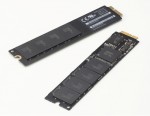After some frustration with stability and latency connecting my virtual pfSense router to my cable and DSL modems, I decided to switch to a physical box. I selected the Netgate RCC-VE 2440 as my hardware platform, since it’s the same box that pfSense themselves use as their OEM bundle. It also checks all the boxes with a dual-core Atom CPU, four Gigabit Ethernet ports, and low-power fanless design. Here’s my first impression and installation notes!
Mini PCI Express
Toshiba Offers “Blade” SSDs (Like Apple’s MacBook Air)
More information about the unconventional SSD used in Apple’s new MacBook Air. As I discussed in my previous coverage of this new flash form factor, it resembles a PCI Express Mini Card but is much smaller. Toshiba has now proved my speculation that the device uses SATA signals rather than the PCI Express lane used by the similar AirPort card. We also know that the lauded performance of the device is due to its chips and controller rather than skipping SATA in favor of PCIe as some had speculated.
Apple’s Unconventional New MacBook Air SSD
Apple updated the ultra-slim don’t-call-it-a-netbook MacBook Air this week. Along with a wimpy out-of-date CPU, the new Air features all-SSD storage of an entirely new and apparently proprietary type. Let’s take a look and see what we can see.
Four Ways to Add eSATA to Your iMac
The latest Intel iMac line is a killer desktop, from its brilliant screen to its excellent performance. But it’s a little lacking when it comes to expansion: A workstation really needs more I/O than five USB and one FireWire port! Since I’m a storage fanatic, my attention naturally turns toward eSATA, and I’m not the only one. Although I’ve come up with three different methods of adding eSATA to my iMac, I haven’t yet taken the plunge and made it happen.


